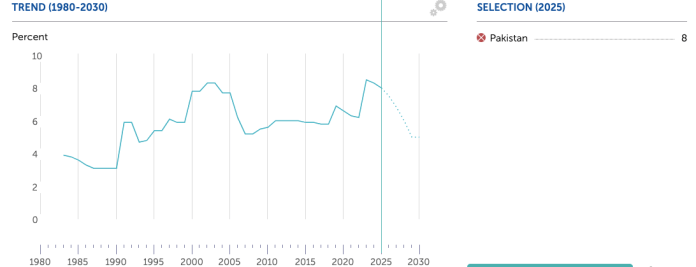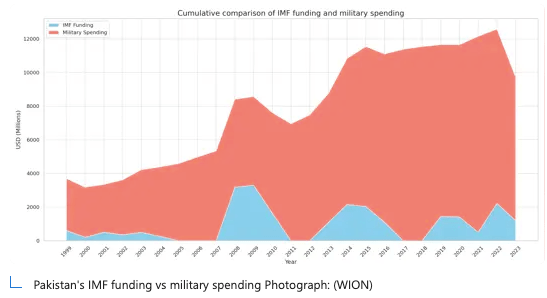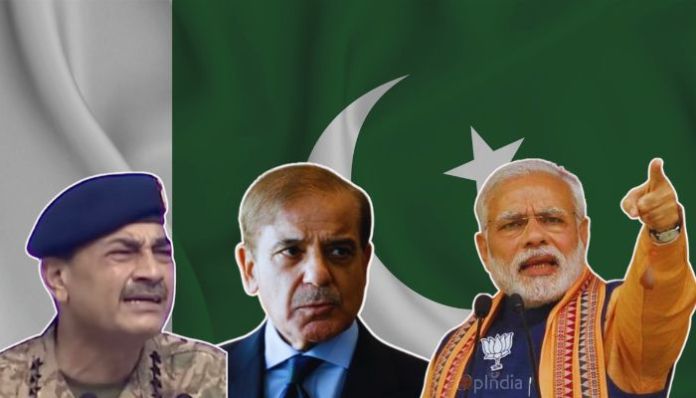


In a classic case of misplaced priorities, Pakistan, whose entire existence revolves around competing with India, is set to increase its defence budget by 18 per cent to over Rs 2.5 trillion ($14 billion) for the fiscal year 2025-26. The Pakistani government’s decision is nothing short of an act of self-sabotage given its economic freefall.
With debt pegged at PKR 76000 billion in the first nine months of the current fiscal year, and debt-to-GDP ratio around 65 per cent, Pakistan is teetering on the edge of collapse. The hostile neighbour’s foreign reserves cover just three months of imports, inflation rates are soaring high, and the stock market took a nosedive by 10 per cent, after India’s Operation Sindoor in May this year.
Despite disappointing performance in terms of economic indicators, Islamabad is prioritising guns over bread, allocating around 18 per cent of its federal budget to defence while slashing funds for poverty alleviation, education and healthcare. It, however, is not surprising as it became clear with Pakistan Army Chief Asim Munir’s promotion to the position of Field Marshal that the country has officially became a military dictatorship masquerading as a democracy.
A terrified and desperate Pakistan prioritising nurturing terrorists over reviving economy
Pakistan’s ruling coalition comprising Pakistan People’s Party (PPP) and Pakistan Muslim League-Nawaz (PMLN) agreed to increasing defence budget exponentially citing ‘war-like’ situation after India embarrassed Pakistan by attacking terror establishments and military bases deep inside the country while Pakistani defence systems remained clueless.
Notably, the 2024-25 defence budget of Pakistan was Rs 2,122 billion, already up nearly 15 per cent from the previous year. This year’s budget surge would be an estimated 35 per cent incremental hike in two years. However, the real defence expenditure would be way higher in the final quarter of this financial year given the increased military activities.
Pakistan’s fear and desperation following India’s snubbing can be understood from the fact that Planning Minister Ahsan Iqbal linked the defence budget hike to India’s decision to scrap the Indus Water Treaty, which is the lifeline of Pakistan and ‘water aggression’ via upstream dam projects. While Pakistan has been letters after letters to India to reconsider its decision of putting the Indus Water Treaty in abeyance, the hostile neighbour is planning to expedite the work of $14 billion Diamer-Bhasha Dam, of course not without the help of ally-cum-foster father—China.
Interestingly, Pakistan is overly prioritising defence budget even as the country’s public debt surged to a record PKR 76 trillion by March 2024, as per its Economic Survey.
It has skyrocketed fivefolds in the last ten years and nearly doubled from Rs 39.8 trillion in 2020–21. The debt consists of overseas borrowings of Rs 24.5 trillion and home liabilities of PKR 51.5 trillion. According to the Economic Survey, fiscal sustainability and economic stability are seriously threatened by high debt levels and inadequate management.
Not to forget, Pakistan is literally on the IMF’s loan ventilator. In May this year, the International Monetary Fund approved $1 billion for Pakistan under the Extended Fund Facility (EFF). The lending body also imposed 11 new conditions on the country. With the new 11 conditions, the total number of conditions for the $7 billion loan has gone up to 50. The IMF also warned Pakistan that escalating military tensions with India could derail the hostile neighbour’s fiscal stability.
As per the IMF data, Pakistan’s unemployment rate in 2025 stands at 8.5 per cent. Meanwhile, Pakistan’s overall poverty headcount, at $4.2 per person, per day, has surged from 39.8 per cent of the total population in 2017 to more than 44.7 per cent in 2021.

As per a latest World Bank report, Pakistan’s poverty rate stands at 42.4%, with 1.9 million additional people falling into poverty in 2024-25, with its 26 per cent economic growth rate proving insufficient to curb poverty. It is a sad reality of Pakistan that the country where 45% of its population is living in poverty and 16.5% in extreme poverty, the army-backed government prioritises raising defence budget by 18 per cent than focussing on reducing poverty rate and providing employment to Pakistani youth.
With reduced water flow in the Indus water basin in Pakistan due to India’s scrapping of Indus Water Treaty, Pakistan’s agriculture sector is also facing challenges. The country’s crop yields are projected to dwindle ranging from 29.6% for cotton to 1.2% for rice, confining sectoral growth to under 2%.
In addition, Pakistan is also grappling with food security concerns as around 10 million people at risk of acute food insecurity in rural areas, as per World Bank report.
“With agriculture employing approximately half of the working poor, rural poverty is expected to rise slightly (0.2 percentage points), while real incomes for agricultural workers are projected to fall 0.7 per cent in FY25. Food security concerns loom large, with an estimated 10 million people at risk of acute food insecurity in rural areas,” the World Bank report reads.
The IMF has bailed out Pakistan with around $22 billion over 25 years, yet the country’s socio-economic reality remains grim. This raises the question as to where this aid is going. This question becomes even more alarming when it turns out that Pakistan spent over $185 billion on its military. The world, especially the lending bodies, need to ask Pakistan that why does the country need IMF and other loans for sustaining economy and for balance-of-payments when it is continuously allocating defence more than five to ten times the IMF loans it took in more than 25 years.

It is evident that IMF loan money has been grossly misused by Pakistan to fund, nurture and shield Islamic terrorists within the country who then function as Pakistan Army’s proxies and carry out terrorist attacks in India. Pakistan’s military dominance has trumped civilian priorities like education, healthcare, and development, not only in this fiscal year, rather, this disgraceful pattern has been Pakistan’s story since many years.
Pakistan’s pathological obsession with bleeding India and competing with a country which has become world third-largest economy, has crippled its thinking.
Gross mismanagement, political instability, Chinese and IMF loans, and a military that literally gobbles up Pakistani resources while delivering little, has been the sad story of India’s hostile neighbour. On one hand, Pakistan has been taking loans after loans to sustain its economy, on the other, this debt-ridden country’s defence budget has only increased over the years along with increase in Pakistan Army and ISI-backed Islamic cross-border terrorism against India.
This is clear indication that the loan amounts are being misused by Pakistan’s de facto ruler—Pakistan Army— to fund, arm and shield terrorist groups like Jaish-e-Mohammed, Lashkar-e-Taiba etc, who are then deployed in India’s Jammu and Kashmir to carry out jihadi attacks. However, it won’t be surprising if Pakistan in its quest to bleed India with a thousand cuts ends up starving its own populace to death.

















































